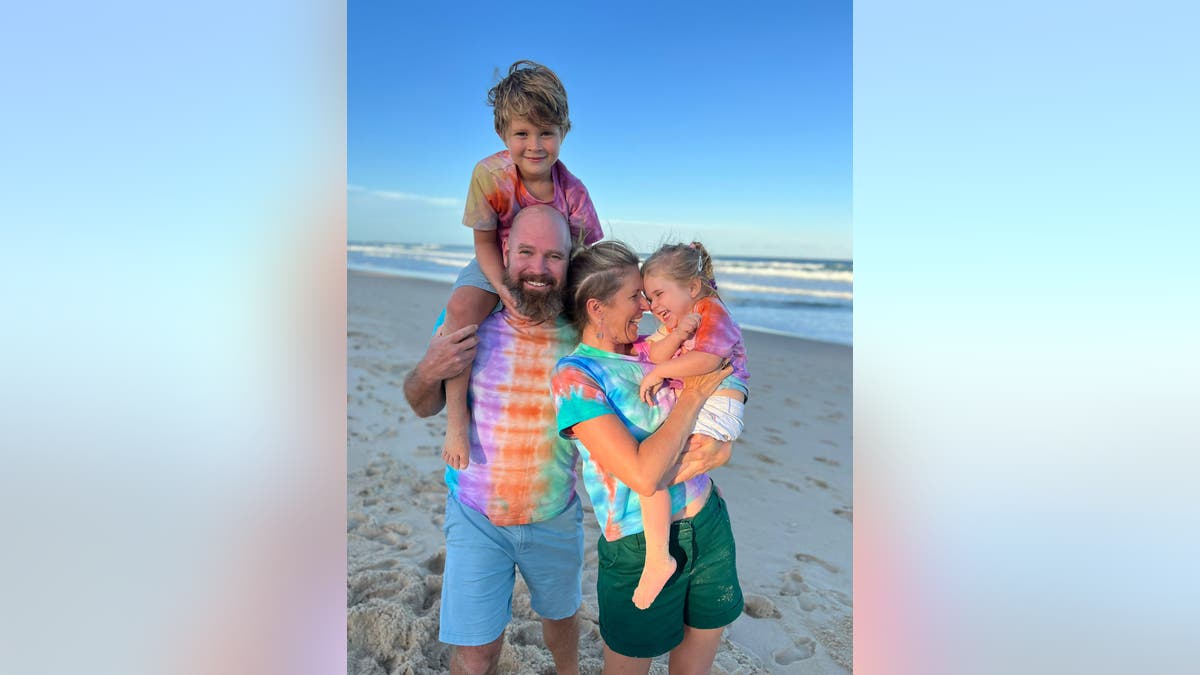A family in Queensland, Australia, is faced with selling their dream home to raise money for their daughter’s life-saving therapy.
Tallulah Moon, 5, has been diagnosed with SPG56, a degenerative brain disease that is caused by a rare gene mutation.
Tallulah was a healthy, happy baby until shortly after her first birthday, when she suddenly began to lose her motor skills.
“She was hitting all of her milestones, and then suddenly she experienced a really steep regression — her abilities sort of fell like an avalanche off the cliff, and it was terrifying,” Golden Whitrod, Tallulah Moon’s mother, told Fox News Digital during an on-camera interview.
Tallulah Moon (left) has been diagnosed with SPG56, an extremely rare neurodegenerative disease that worsens over time. Her mother, Golden Whitrod (right) is committed to finding and funding the genetic therapy to save her daughter. (Our Moon’s Mission/Golden Whitrod; Sara Climie Photography)
“She went from a little girl who was walking and talking to suddenly not even being able to sit up on her own, not being able to lift her arms above her shoulders or hold up her neck,” Whitrod said.
Swallowing and choking also became a concern.
“We’d gone from watching this beautiful child thrive at 14 months, to regressing to the abilities of a 4-month-old,” Whitrod recalled.
Tallulah Moon was also terrified, unable to comprehend the loss of her abilities.
“I remember her looking at us as if to say, ‘Why can’t you help me?’” her mother said. “And I could feel that as a parent. I just didn’t know what to do.”
A devastating diagnosis
At first, Whitrod hoped there would be an easy fix for whatever was causing Tallulah’s decline.
After six months of testing and scans, doctors performed a genetic study known as whole genome sequencing (WGS), leading to Tallulah Moon’s diagnosis of SPG56 in August 2020.

Tallulah Moon, then age 3, is pictured at the family’s home in Darwin, Australia, which the family has put up for sale to fund their mission to cure their daughter of SPG56. (Our Moon’s Mission/Golden Whitrod)
SPG56 is a type of hereditary spastic paraplegia (HSP) that usually begins around age 1 or 2 and worsens over time, causing muscle weakness and gradually robbing children of the ability to walk, talk, stand and sit up, as seen in past cases.
In later stages, the disease can cause cognitive decline, seizures and even an inability to swallow.
SPG56 is one of the rarest types of HSP, affecting fewer than one in every million children, statistics show.
“We’d gone from watching this beautiful child thrive at 14 months, to regressing to the abilities of a 4-month-old.”
There is currently no cure for the disease.
“The doctors told us, ‘just love your baby,’” Whitrod said. “They said there was nothing they could do — that there were no treatments.”
A mother’s determination
After “coming out of the fog” post-diagnosis, Whitrod immersed herself in research, making connections with other families whose children were also living with rare genetic diseases.
One of those was Terry Pirovolakis, a Canadian father whose son was diagnosed with SGP50, a disease that is very similar to Tallulah Moon’s SPG56.
Pirovolakis immediately started researching to find a gene therapy that could help his son.

Whitrod (at left) met with scientists at genetic institutes and carefully built her own research team. (Our Moon’s Mission/Golden Whitrod)
After meeting with experts from around the world, he liquidated his life savings and paid a team of researchers to start developing the therapy. In 2022, after massive fundraising efforts, his son received the one-time treatment, which halted progression of the disease.
Following Pirovolakis’ lead, Whitrod met with scientists at genetic institutes and carefully built her own research team.
STIFF PERSON SYNDROME PATIENTS SHARE WHAT IT’S LIKE TO LIVE WITH THE RARE DISEASE
Over a three-year period, the team created an experimental gene therapy for SPG56, which Whitrod calls a “massive win.”
The next step is for the therapy to go through clinical trials to make sure it’s safe and effective for the children who need it — but the cost is too high for the vast majority of families to cover.
It will require a staggering $3 million to manufacture the medication before it can be administered to Tallulah Moon in a clinical trial, according to Whitrod.

Chris (left), Finn (top), Golden and Tallulah Moon enjoyed a day at the beach on International Rare Disease Day 2023. (Our Moon’s Mission/Golden Whitrod)
“Unfortunately, the big pharmaceutical companies just aren’t interested in funding the research for these rare diseases, even though the treatments are possible,” she said.
“We realized that we have to fund this on our own if we want to do this.”

Parents Golden and Chris Whitrod with daughter Tallulah Moon, 5, who lives with the neurodegenerative disease SPG56 (Sara Climie Photography)
Walter Gaman, MD, founder of Executive Medicine of Texas, emphasized the financial burden that often comes with rare diseases.
“Rare diseases, by nature, account for a small market share, meaning that there are few customers to absorb the cost of bringing effective drugs to market,” Gaman, who is not affiliated with the Whitrod family, told Fox News Digital.
“We realized that we have to fund this on our own if we want to do this.”
In 2003, Deloitte reported that the average cost of bringing a drug to market exceeded $2 billion, according to Gaman.
“One of the most significant wins for orphan drugs came in 2017, when President Trump signed the Food and Drug Administration Reauthorization Act (FDARA) into law,” he noted.
“This was a huge win for orphan therapies because it expanded the FDA Rare Disease Program and also expedited the review process. As a result, 2018 saw a record 59 orphan drugs greenlighted. We need to build that momentum up once again.”
In 2003, the average cost of bringing a drug to market exceeded $2 billion.
There is still a lot of work to do, he noted.
“We need to bring orphan drugs to market, but we also need to look at ways of making these drugs more affordable to the end user,” Gaman said.
Some potential ideas are to offer tax breaks to companies that champion such drugs, or to have a tax on pharmaceutical companies that goes directly to the FDA Rare Disease Program, he suggested.
A ‘much bigger dream’
“We’re standing at the precipice of there being a treatment for Tallulah and for children in her position,” Whitrod said.
“We feel like we’re almost there. But, of course, $3 million for a little Aussie family is quite a lot.”
CLICK HERE TO GET THE FOX NEWS APP
The Whitrods have launched a charitable foundation called Genetic Cures for Kids, with a fundraising initiative called Our Moon’s Mission.
The family has raised some funds through donations, but it’s only a fraction of what is needed to treat Tallulah Moon — hence their decision to sell their home.
The house, which is located in the suburb of Stuart Park, is scheduled to go up for auction this week.

Golden Whitrod (left), mother of Tallulah Moon, has built a research team to identify the medication for her daughter’s genetic disorder. (Our Moon’s Mission/Golden Whitrod)
“We’d hoped that some miracle would happen and we wouldn’t need to sell it, and that help would come before we needed to come to this crunch point,” Whitrod said.
“But in the end, we realized that’s our last asset that we have, and that could help us get to the finish line.”
CLICK HERE TO SIGN UP FOR OUR HEALTH NEWSLETTER
While they are sacrificing their family’s “dream home,” Whitrod says they are now aspiring to a “much bigger dream.”
“That is to give Tallulah the life she deserves — and we’re all in for that.”

While she is intent on saving her daughter, Whitrod has also set her sights on a wider goal — to help other families whose children are facing similar challenges. (Sara Climie Photography)
Meanwhile, Whitrod said, Tallulah Moon is working to fight the neurodegenerative disease through physiotherapy, occupational therapy and speech therapy.
For more Health articles, visit www.foxnews.com/health
While she is intent on saving her daughter, Whitrod has also set her sights on a wider goal — to help other families whose children are facing similar challenges.

Golden Whitrod is pictured with her daughter, Tallulah Moon, a 5-year old living with the rare neurodegenerative disease SPG56. (Sara Climie Photography)
“What we’re creating is not just a treatment for Tallulah that ends with the kids with SPG56 — we’re creating a replicable framework, so the researchers can go on to create treatments for other similar diseases,” she said.
“If we can get there in time, then we can help Tallulah live the life she deserves — and not just her, but also lots of children just like her.”



